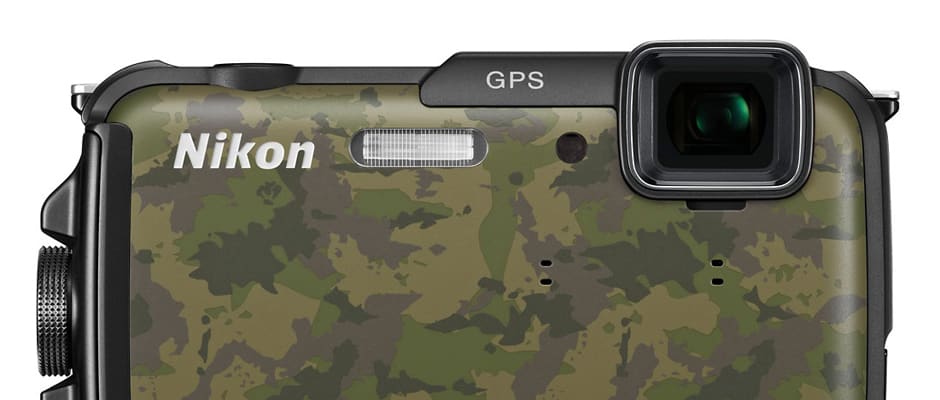Our First Take
The AW110 doesn’t attempt to fix what wasn’t broken on the AW100.
At CP+ 2013, Nikon has announced the follow-up, the AW110 (MSRP $349.95). The new model stays the course with the same sensor and a very similar lens, but adds WiFi connectivity, switches to an OLED screen, and extends the ruggedization specs significantly. We’ve gotten our paws all over it here in Yokohama, much to the chagrin of Nikon’s cloth-wielding booth attendants.
Design & Usability
Small, sleek, and superbly built
Unlike some other toughcams, the AW110 doesn’t go overboard on masculine aesthetics. It doesn’t look like a Tonka toy and it isn’t covered in gleaming metal rivets. The AW110 is surprisingly understated, actually, with a glossy, brightly colored front face and a matte black rear and sides. It exudes quality, too; since it’s small but not featherweight, it has a nice feeling of density, and it’s very solidly put together. The screw-locked battery/memory/port compartment is a confidence-inspiring touch, feeling a bit like a mini bank vault when you open it.
Grip is minimal. There’s a pattern of raised plastic bumps on the rear, between the zoom lever and the main control cluster, but it didn’t do much to enhance our feeling of security when holding the AW110. Around front, there’s nothing but smooth surface. Don’t forget to attach the wrist strap!
The buttons are laid out intelligently and have plenty of travel, with excellent tactility when you click them. The shutter button in particular is extra-large and textured, so it should be easy to find even when wearing diving gloves. Like other toughcams, the shutter button here is extra spongy, so you have to firmly press it to take a shot. Focus acquisition was quite quick in our tests, even in poor/mixed lighting, but we were a little frustrated with having to manually switch to macro mode to shoot up close.
The new OLED monitor is extremely bright and colorful. Nikon claims the display is optimized for outdoor use, and says it’s equipped with an anti-reflective coating for easier viewing in direct sunlight. While we weren’t able to test the camera under those conditions here at CP+, we were impressed with what we saw in artificial light. The display isn’t the highest-res out there at 614k dots, but we were still able to accurately judge the sharpness of shots when zooming in on them in playback.
Nikon’s action button has a simple premise: Sometimes you won’t be in a position to navigate the menu system with your hands, so if you press the large action button, you can page through menu options by shaking the camera up and down. It worked fairly well in our brief trial, but we’d probably only use it as a last resort.
{{photo_gallery "gallery"}}
Features
Wireless and Points of Interest are nice, but the biggest upgrade here is 59-foot waterproofing. (Okay, that screen is nice, too.)
Like so many other cameras these days, one of the AW110’s supposed killer features is integrated WiFi. Nikon is touting that the WiFi even works underwater, though we’re not sure how many pools or oceans have hotspots. You’re certainly not going to be getting WiFi out on the trail, either, unless you manage to tether to a smartphone. But anyway, Nikon’s implementation is pretty well done. The camera can either connect to a local WiFi hotspot, or directly to a compatible smart device running the company’s free Wireless Mobile Utility app.
The other big selling point of the AW110 is its improved ruggedization. Where the AW100 could go down to 33 feet underwater, the AW110 can hit 59 feet. Where the AW100 could survive a 5-foot drop, the AW110 can do 6.6 feet. Like most other rugged cameras, the AW110 can be used down to 14 degrees Fahrenheit. Some other toughcams advertise their crushproofing, but Nikon is silent on this point.
Nikon’s GPS integration was already among the best in town on the AW100, and it’s been improved on the AW110. New is the Points of Interest feature, which will alert you when you’re close to something worth shooting. Like the earlier model, the AW110 can also map your progress on an expedition, automatically tag shots with your current location, and so on. A built-in electronic compass, altitude/depth, and atmospheric pressure info are shown on the live view display, updated in real-time.
Down in the guts of the AW110, little has changed from the previous model. We’re still looking at a tiny 16-megapixel CMOS sensor with an ISO range of 125–1600 (expandable to ISO 3200). The lens still covers a 28–140mm range with a max aperture of f/3.9–4.8. The number of elements and groups has changed (11/9 on the AW110 vs 12/10 on the AW100), but we expect little difference in image quality.
We shouldn’t leave this section without again mentioning the OLED display, which we feel is a great choice for an adventure camera. This is probably the nicest screen we’ve seen on a camera in this class, and we hope it’s a sign of things to come from other manufacturers.
Conclusion
If you’re on a budget, it’ll probably get the job done as well as many higher-priced competitors.
On the whole, we were impressed with the AW110. It does what it sets out to do quite well, and it’s among the most rugged cameras in its class, at least according to the spec sheet. While it lacks an exciting fast lens or a big sensor, it has fantastic build quality, a great display, and good ergonomics (lack of a grip notwithstanding). More importantly, with an MSRP of $349.95, it’s a real bargain compared to some of its rivals from Olympus, Pentax, and Panasonic.
The enthusiast in us would like to see someone break the mold and release a fully waterproofed advanced compact—something along the lines of a Sony RX100 or even a Canon S110. Of course, we understand that the seals and extra support used to ruggedize a camera take up valuable space that could otherwise be used for a bigger lens and sensor. We only hope that in the future, new breakthroughs in materials and assembly techniques can make such a thing possible.
For now, the AW110 joins a very crowded toughcam market. Manufacturers realize that the low-end compact camera is an endangered species, and they’re rushing to fill the void with features smartphones can’t match (or haven’t yet, anyway). Waterproofing is one of these. We still think the Olympus TG-2 will be a better camera, but for those on a tighter budget, we think the AW110 might fit the bill. Keep an eye out for our full-length, lab-tested review in the near future.
Meet the tester
Ben is an experienced industry journalist who formerly served as Senior Editor of News and Features at Reviewed. He now contributes as a freelance writer and editor. Most recently hailing from the vast wilds of the American southwest, he is an avid photographer who is deeply disturbed by the lack of wide open landscapes in Boston.
Checking our work.
Our team is here to help you buy the best stuff and love what you own. Our writers, editors, and experts obsess over the products we cover to make sure you're confident and satisfied. Have a different opinion about something we recommend? Email us and we'll compare notes.
Shoot us an email

